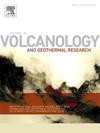武尔卡诺(意大利西西里岛)火山气体的痕量元素迁移--物种、沉积和通量
IF 2.4
3区 地球科学
Q2 GEOSCIENCES, MULTIDISCIPLINARY
Journal of Volcanology and Geothermal Research
Pub Date : 2025-02-01
DOI:10.1016/j.jvolgeores.2024.108235
引用次数: 0
摘要
对武尔卡诺(意大利西西里岛)火山气体排放中微量元素的地球化学进行了研究。94-412 °C烟气中的微量元素浓度超过 10 个数量级,从 ∼0.01 pmol/mol 到 ∼300 μmol/mol,其中某些金属元素(B、Si)含量最高,其次是碱金属、碱土金属和某些过渡金属,稀土元素的浓度通常最低。TiOCl2、VOCl、VOCl2、VOCl3、NbOCl3、Cr(OH)3、CrCl3、Fe(OH)2、FeCl2、Co(OH)2、CoCl2、Ni(OH)2 至 NiCl2、Cd(OH)2、CdCl2、Re(OH)3、ReCl3、ZnCl2、AgCl、WO2(OH)2、Al(OH)3、Si(OH)4、B(OH)4、TlO、GaCl3、SbCl、MnCl2、CuCl)。硫化物、水合物和元素气体种类对某些元素(Cd、AuS、Hg、PbS2、BiS、Bi、AsS、As2S3、TeS、SeH、SeS)也很重要。然而,由于缺乏热力学数据,许多痕量元素的种类仍然不确定或未知。据预测,在火山气体冷却和减压后,大多数微量元素会达到气固平衡,从而形成次生矿物。在高温下(700-1000 °C),形成的矿物组合主要是石英、Ca-Na-K 长石和镁辉石,并含有少量其他碱金属和碱土金属。进一步冷却和减压后形成的矿物包括磁铁矿、黄铁矿、黄铜矿和黄铜矿,以及其他含量较少的氧化物(V、Cr、Ga、W 和 Sn)和硫化物(Zn、Pb、Ni、Co、Cr 和 Sn)、Pb、Ni、Co、Cd、Mo、Ag、As 和 Bi),并最终在最低温度下(∼100-300 °C)产生一系列硫酸盐和硫酸盐(Li、K、Na、Rb、Cs、Be、Mg、Ca、Sr、Bi、Mn、Fe、Zn、Pb 和 Sn)。对于大多数痕量元素,烟孔排放浓度反映的气固平衡温度比采样时观测到的温度要高,这表明气固在高温下达到平衡,然后在地表附近进一步冷却后未完成再平衡。硅、铝和硼的通量一直最高,其次是碱金属和碱土金属、各种过渡金属和类金属,稀土元素和锕系元素的通量最低。一般来说,与邻近的斯特龙博利和埃特纳相比,微量元素通量较低,但铅、铋、硼、砷、锑和碲除外。本文章由计算机程序翻译,如有差异,请以英文原文为准。
Trace element transport by volcanic gases at Vulcano (Sicily, Italy) – Speciation, deposition and fluxes
The geochemistry of trace elements in volcanic gas emissions at Vulcano (Sicily, Italy) was investigated. Trace element concentrations in 94–412 °C fumarole gases span over 10 orders of magnitude, from ∼0.01 pmol/mol to ∼300 μmol/mol, with some metalloids (B, Si) being the most abundant, followed by alkali, alkaline earth, and certain transition metals, and rare earth elements typically displaying the lowest concentrations. Thermodynamic modeling predicts most trace elements to be transported as chloride, hydroxide, and mixed hydroxy-chloro gas species (LiCl, KCl, NaCl, RbCl and CsCl, Be(OH)2, Mg(OH)2, MgCl2, CaCl2, SrCl2, CaCl(OH), TiOCl2, VOCl, VOCl2, VOCl3, NbOCl3, Cr(OH)3, CrCl3, Fe(OH)2, FeCl2 Co(OH)2, CoCl2, Ni(OH)2 to NiCl2, Cd(OH)2, CdCl2, Re(OH)3, ReCl3, ZnCl2, AgCl, WO2(OH)2, Al(OH)3, Si(OH)4, B(OH)4, TlO, GaCl3, SbCl, MnCl2, CuCl). Sulfide, hydrate, and elemental gas species are also important for some elements (Cd, AuS, Hg, PbS2, BiS, Bi, AsS, As2S3, TeS, SeH, SeS). However, for many trace elements, speciation remains uncertain or unknown due to a lack of thermodynamic data. Upon cooling and decompression of the volcanic gas, most trace elements are predicted to reach gas-solid equilibrium, resulting in the formation of secondary minerals. At high temperatures (∼700–1000 °C), the mineral assemblage forming is dominated by quartz, Ca-Na-K feldspars, and Mg-pyroxene, containing minor concentrations of other alkali and alkaline earth metals. Further cooling and decompression leads to the formation of minerals including magnetite, pyrite, chalcocite, and chalcopyrite together with other less abundant oxides (V, Cr, Ga, W, and Sn) and sulfides (Zn, Pb, Ni, Co, Cd, Mo, Ag, As, and Bi), and eventually a range of sulfates and sulfosalts (Li, K, Na, Rb, Cs, Be, Mg, Ca, Sr, Bi, Mn, Fe, Zn, Pb, and Sn) at the lowest temperatures (∼100–300 °C). For most trace elements, fumarole emission concentrations reflect higher gas-solid equilibrium temperatures than those observed during sampling, suggesting gas-solid equilibria at high temperatures followed by incomplete re-equilibration upon further cooling near the surface.
Trace element fluxes span over eight orders of magnitude, ranging from >100 kg/day to ∼1·10−6 kg/day. Silica, Al, and B consistently exhibit the highest fluxes, followed by alkali and alkaline earth metals, various transition metals and metalloids, with rare earth elements and actinides displaying the lowest fluxes. Generally, the trace element fluxes are lower compared to neighboring Stromboli and Etna, except for Pb, Bi, B, As, Sb, and Te.
求助全文
通过发布文献求助,成功后即可免费获取论文全文。
去求助
来源期刊
CiteScore
5.90
自引率
13.80%
发文量
183
审稿时长
19.7 weeks
期刊介绍:
An international research journal with focus on volcanic and geothermal processes and their impact on the environment and society.
Submission of papers covering the following aspects of volcanology and geothermal research are encouraged:
(1) Geological aspects of volcanic systems: volcano stratigraphy, structure and tectonic influence; eruptive history; evolution of volcanic landforms; eruption style and progress; dispersal patterns of lava and ash; analysis of real-time eruption observations.
(2) Geochemical and petrological aspects of volcanic rocks: magma genesis and evolution; crystallization; volatile compositions, solubility, and degassing; volcanic petrography and textural analysis.
(3) Hydrology, geochemistry and measurement of volcanic and hydrothermal fluids: volcanic gas emissions; fumaroles and springs; crater lakes; hydrothermal mineralization.
(4) Geophysical aspects of volcanic systems: physical properties of volcanic rocks and magmas; heat flow studies; volcano seismology, geodesy and remote sensing.
(5) Computational modeling and experimental simulation of magmatic and hydrothermal processes: eruption dynamics; magma transport and storage; plume dynamics and ash dispersal; lava flow dynamics; hydrothermal fluid flow; thermodynamics of aqueous fluids and melts.
(6) Volcano hazard and risk research: hazard zonation methodology, development of forecasting tools; assessment techniques for vulnerability and impact.

 求助内容:
求助内容: 应助结果提醒方式:
应助结果提醒方式:


